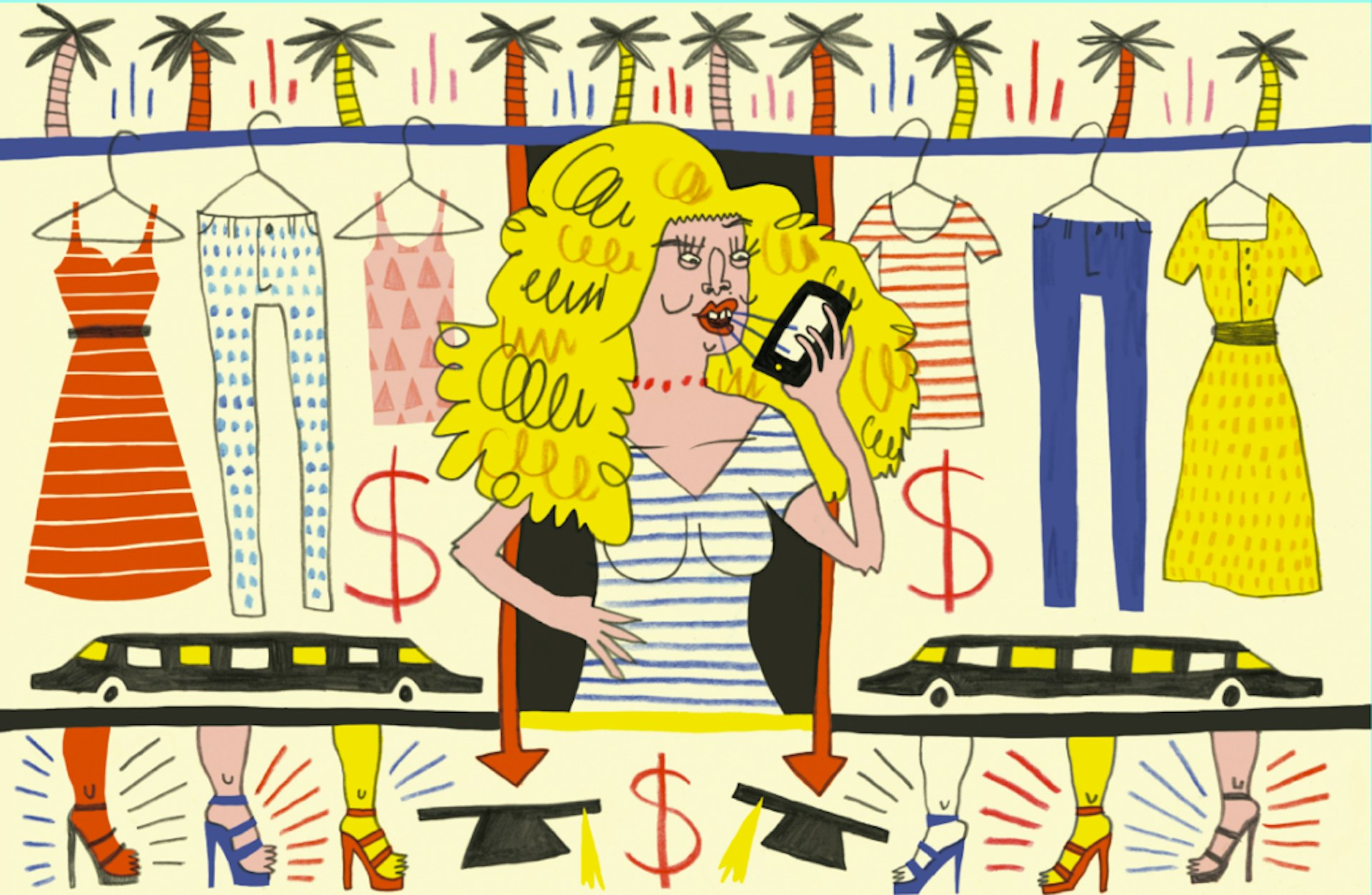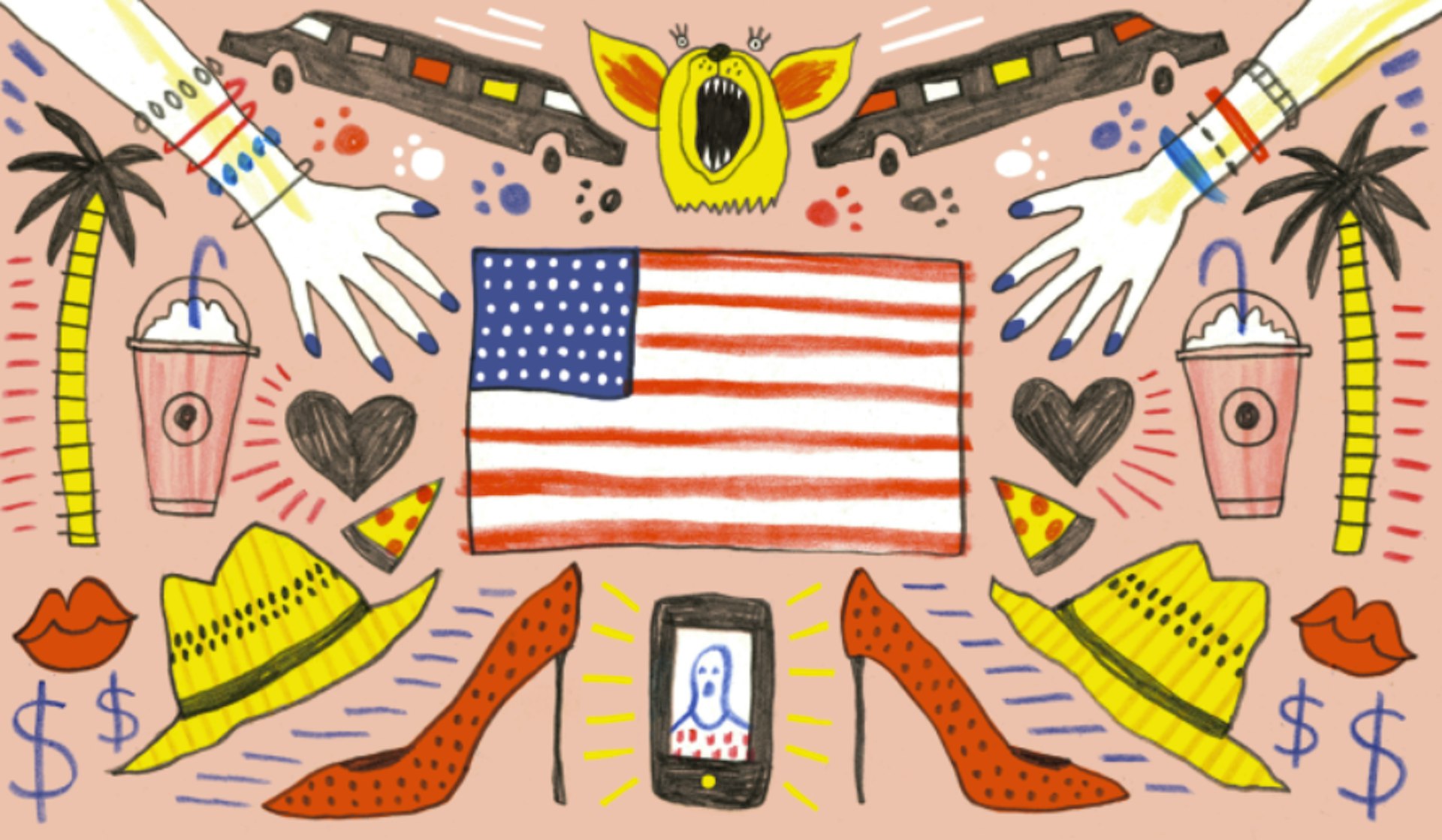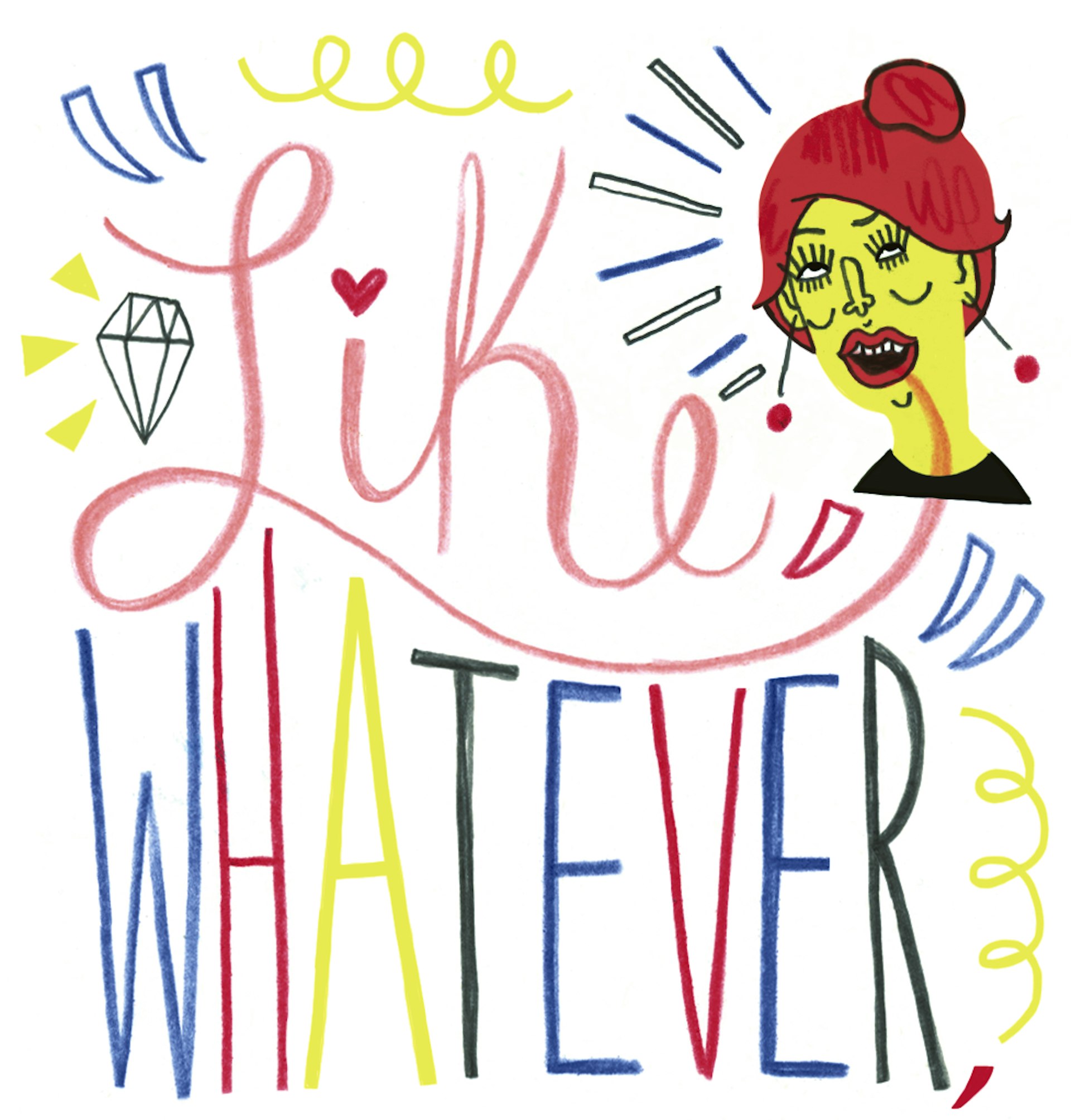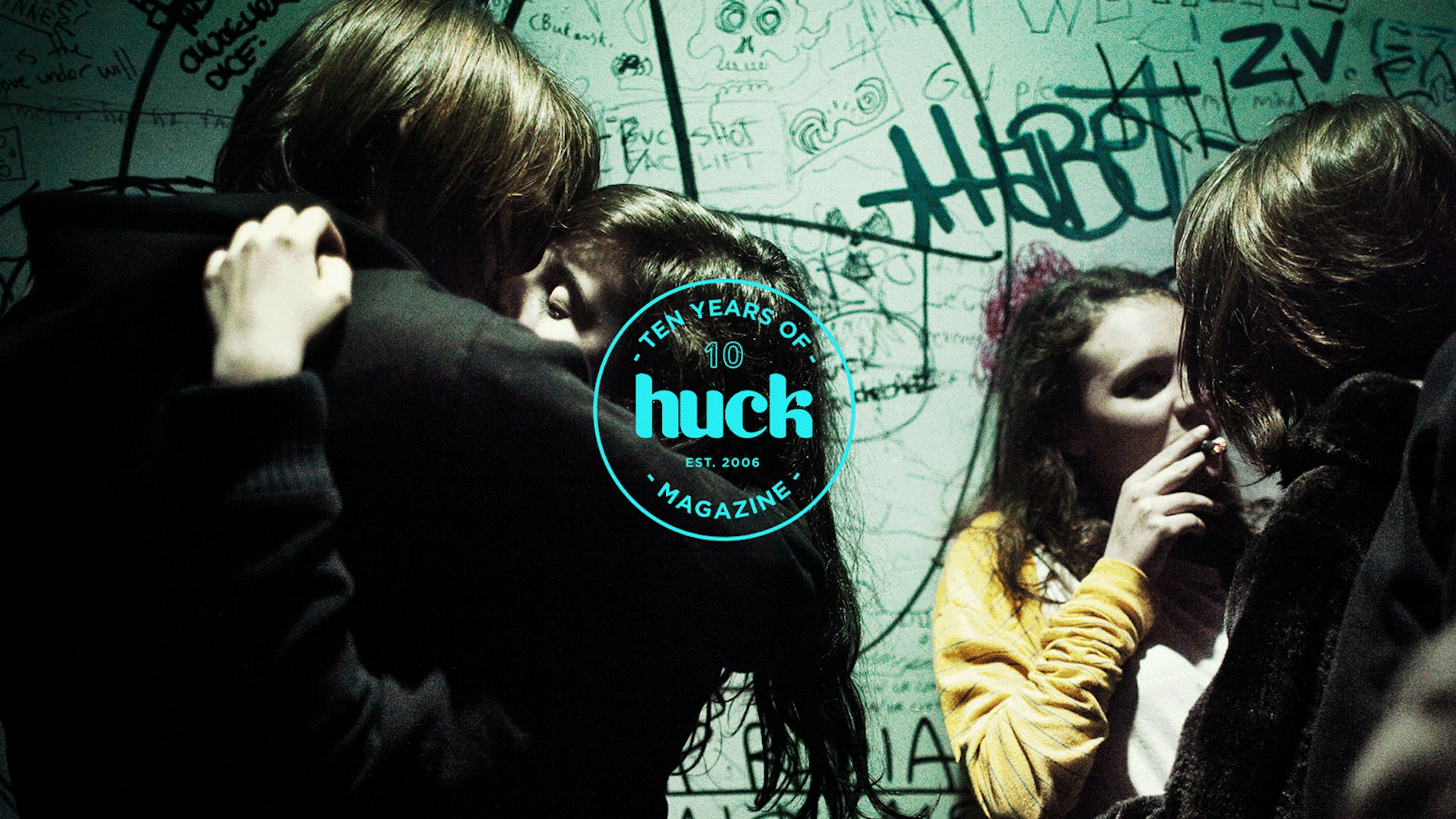
Do Valley Girls still exist?
- Text by Mike Fordham
- Illustrations by Allison Kerek
Katy rolls her eyes as she sips on her acai and green tea Slurpee.
Her hair is newly auburn and freshly bouffant, her naturally golden skin adorned immaculately with smoky eyes and long, delicately curled lashes. Her nails, clasping the carton, are painted the colour of slightly under-ripe blueberries.
“I don’t know. I suppose you’re looking at a Valley Girl!”
Friday night. I’m leaving downtown LA at sunset and pushing out onto the 405 up the canyon towards the Simi Valley.
Supercharged hot rods of the apocalypse nestle next to the ubiquitous Toyota Prius and form a necklace of red lights reaching to vanishing point.
A cacophony of steel and gasoline and reflections line the barricades from the Los Angeles basin to points north and west.
In every cabin, if you dare to look, there is a human interacting with a smartphone or a tablet as the eight-lane gridlock edges forward in staccato-staccato flow.
Somewhere out there in the black, beyond the etched outline of the hills, lies a flatland of dormitory tracts and strip-malls. We are heading to The Valley.
Do Valley Girls still exist? I ask the question to Katy, a 24-year-old Simi resident at a party later that night. On top of Katy’s mane there is tipped jauntily a straw trilby with a navy and white band, and her left arm is inked beautifully with hibiscus, rose and lily.
She has striking, strong features and her breast augmentation is understated yet, apparently, rather expensive.
“I think my mom was an original Valley Girl and I suppose I am. I live in the Valley. But not that Valley,” she says, referring to the San Fernando Valley – the bigger conurbation to the south east of here. “I like to go shopping… but who doesn’t?”
Katy drives a “super cute” Mini Cooper, owns a blonde chihuahua called Loca who goes with her everywhere, and has just bought tickets for the Fleetwood Mac concert at the Hollywood Bowl.
She works in administration in a family engineering company, is going to school part-time to try to get into nursing, and runs an online vintage clothing shop on the side.
“If I am a real Valley Girl, then I guess I’m proud. It doesn’t mean you have to be a dumbass.”
There is an infectious inflection in her voice – and her speech is shot through with the kind of rhythms and glottal stops that, in another decade, may have been definitive of the Valley Girl stereotype.
But today, this is an archetype whose range outstrips the confines of the Santa Susana Mountains – and even those of America itself.
Chuck ‘Valley Girl’ into Google’s maw and you’ll get myriad origins, manifestations and affectations. Like many class-defined terminologies and subcultural lexicons, the consensus seems to be that it was a 1980s coinage – and the words ‘vapid’, ‘materialistic’ and ‘airhead’ pop up all the time.
There is reference to Frank Zappa’s strangely vicious track from 1982, in which his daughter, ‘Moon Unit’, raps a litany of ‘Val-speak’ against a jarring chorus chant and hard-edged riffs.
Reading directly from these digital runes it would be easy to trace the genealogy of the term. If Zappa represents the extension into the ’80s of that Topanga-flavoured, coked-and-quaaluded version of 1970s SoCal Bohemia, the Valley Girl was its antithesis.
She was the child of the boomers who had everything handed to them on a plate. She had seen the counterculture come and go and her version of non-conformity was living to excess.
If the hippies wanted to turn on, tune in and drop out, Valley Girls were the most visible manifestation of a generation that succeeded them – one that would rather act up, party hard and go shopping.
In a way, the archetype signified by the term has its equivalence in every modern city. The Valley Girl might be to LA, for example, what the ‘Essex Girl’ is to London.
Watch John Badham’s 1977 disco flick Saturday Night Fever, meanwhile, for a brilliant evocation of how the ‘Bridge and Tunnel’ kids from the outlying Boroughs came to define the action in late ’70s and early ’80s New York.
In Tokyo, meanwhile, there have been accelerated versions of she-cults for whom consumption and tanning were an end in itself.
But here in Southern California – so far ahead of the curve and definitive of so many cultural threads that extend outwards to the rest of the planet – a hybridisation has been moving on apace.
If the Valley Girl aesthetic is definitive of mainstream attitudes to consumption the world over, the girls actually living in the Valley are already way downstream.
It helps, when baffled by any cultural construct, to trace its trajectory back through the past.
In the post-war, chrome-clad boom-time years, Hollywood was establishing the play of images that would seduce a planet.
The hard-edged contrasts on-screen would define the promise of light for sun-starved Europeans while the showier side of Hollywood defined the imaginary excesses.
The Valleys further inland, meanwhile, were a halcyon just a little way away from the burgeoning mad- ness of LA itself. There were walnut plantations, pear orchards; fields full of almond shrubberies and endlessly fruitful orange groves.
Jasmine-scented banks of flowers fringed a world that was out on the edge of things but domesticated enough to build a very European version of the American Dream.
Between 1945 and 1960, hundreds of thousands of homes were built and sold there; $150 down would get you an easy mortgage on a $4,000 home. The population exploded.
As the Cold War era pushed on and America was stripped of the innocence its defining aesthetic clung to, the development continued.
By the 1970s, the flatlands defined by the Santa Susana and San Fernando hills had become an etherised beast, sprawled out on a slab just over the hill from Malibu, intoxicated with its own success and basking in the permanent clemency of the Southern Californian climate.
In a few brief years every gridded street was laid out and constructed with the ubiquitous timber framing, slope-fronted yards with double garages. The bigger plots were planted with a pool, of course, and the front porch often adorned with Old Glory.
The families that had made it here, after all, had much to celebrate. This was America. This was Southern California. There was nothing further to reach for in terms of aspiration.
And with the arrival at an end point, the only thing to do was aspire to be even more than the thing you were: the freest individuals that have ever lived. Free, that is, as long as you had enough of the dollar that was the vector of this freedom.
I met Ashley in the Topanga Mall. This place, which opened its doors in 1964, is the first fully enclosed shopping centre in California – and as such can be seen as the spiritual home of the Val.
Today, predictably, it is a Westfield – and it is by far the maddest cathedral of consumption I have ever visited. Strangely cutting edge, it tangibly whispers of The Future.
Mad juxtapositions seem, to my Londoner’s eye, everywhere. There is an auto gallery: a kind of porn shop for petrol heads, full of Ferraris and Lamborghinis and Porsches and Rolls Royces that don’t seem to be on sale but are transformed into totems of high-end window shopping.
There is a store that only sells flip-flops but is the size of my local Lidl. And among many other oddly grotesque food outlets there is a Potato World, where you can customise your own crisps chips.
There are zen gardens, calmly whispering waterfalls where anatomically exact clones of Lindsay Lohan patrol the peripheries of the shopfronts. I sit on a bench in the Starbucks section of one of the food halls when I first see her.
Ashley is very small and wears an extremely voluminous mane of platinum white hair, though she could be of Mexican or Chinese ethnicity. She is walking in a pair of red cork-wedge sandals and high-cut, skin-tight, near white stone-washed leg wear (they might be jeggings).
In her left hand she deftly negotiates her iPhone, using a long, orange-painted thumbnail to fling content, I presume, up to the web. She has crooked in her right arm a shopping bag from Jimmy Choo and a couple of peripheral, less conspicuous paper sacks artfully embroidered with the logos of a brand I fail to recognise.
Slung over her left shoulder, however, is an auspiciously authentic tote from Louis Vuitton. She walks, as is the tradition here, as if lit by her own personal cinematographer.
And though no one is watching but me, lurking to the side with an iced non-dairy latte trying not to appear predatory, there is a kind of self-conscious confidence in her manner that strikes me immediately.
She looks up for a moment and makes a sharp left turn and joins the short queue adjacent to where I sit. “Hello,” I say, doing my best Hugh Grant. “Can I ask you a question?”
“The thing about the term Valley Girl is that it is just another way of stereotyping someone.” Ashley looks me straight in the eye. And I feel dumber than any Essex boy in history.
“I have never fitted into any category. And I certainly am not prepared to fit into a category so meaningless as ‘Valley Girl’.” She speaks in a quick, urgent patter that is devoid of the inflections that are the Val-speak cliché.
“What are you doing here speaking to strange girls, anyway?”
Chastened by the way that Ashley sees her way through my faux-naivety, I tell her I’m kind of here kind of doing a story on Valley Girls for a magazine in London.
“Well, you guys should know that it’s kind of a meaningless term,” yes, she mocks me. “My cousins, my uncle, they call me a hipster,” she says.
“My dad knows me best and my mom just thinks I’m cute. I don’t really care what you want to call me. I’m interested in everything, and I love to shop – so what? It doesn’t make me fit into your categories.”
It turns out that Ashley is studying business at Pepperdine University and already has a “million-dollar-valued” clothing line.
She was given a kickstart by her father (a successful Mexican-American businessman, apparently) and she hopes that once she has her master’s she will sell the company to dad and start afresh with something new.
What is immediately apparent is that if the Valley Girl lives here, then what you thought were the motifs of the Valley Girl are not there anymore.
“I suppose it’s true. I’m a Valley Girl,” Katy had told me as she left the party that first night in the Valley. “But the thing is, when I was in Europe last summer I felt completely at home. There were people like me everywhere.” She jumped in her Mini and disappeared into the balmy Valley night.
As we continue to tweak our identities beneath increasingly detailed layers of influence – seeking out and adopting, at the click of a button, little offcuts from cultures near and far – those red cafeteria benches that once housed ‘Hipsters’, ‘Stoners’ and ‘Gamer Geeks’ are inhabited now by cross-pollinated hybrids who refuse to subscribe to any one tribe.
And yet, there’s a truth in Katy’s closing statement. Wherever you go, whatever you do, there is a Valley Girl to be found.
If the Valley Girls of the 1980s were harbinger of a future defined by consumption, then that future is here, there, everywhere. We’re all Valley Girls now.
This article originally appeared in Huck 39 – The Sofia Coppolla Issue. Subscribe today to make sure you never miss another issue.
Enjoyed this article? Like Huck on Facebook or follow us on Twitter.
